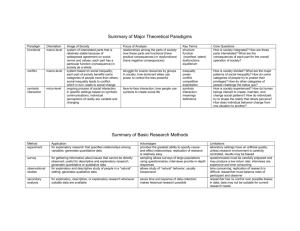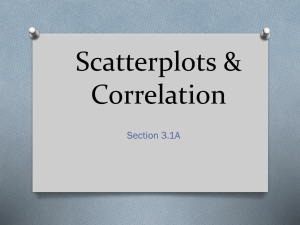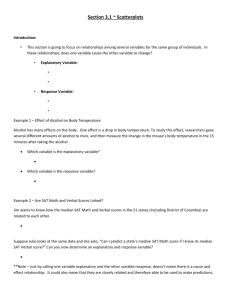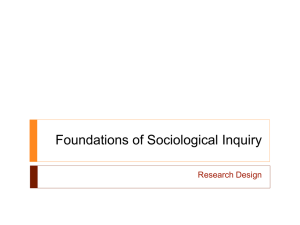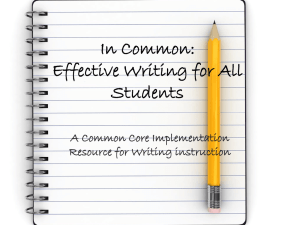Level 7 experiments notes - Auckland Mathematical Association
advertisement
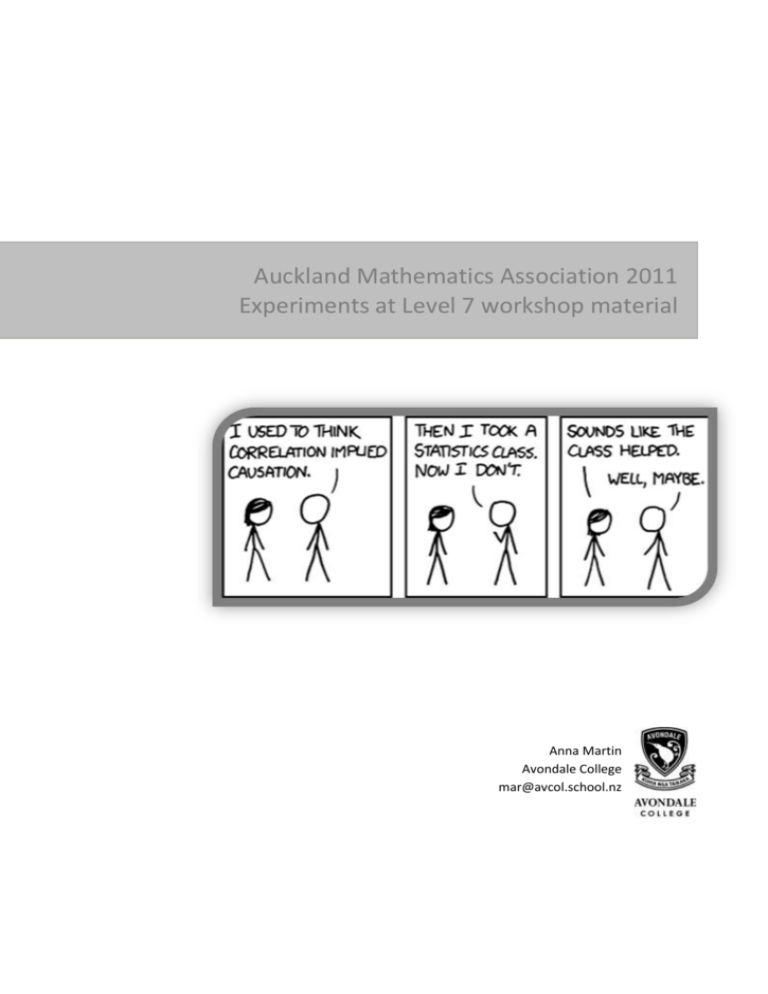
Auckland Mathematics Association 2011 Experiments at Level 7 workshop material Anna Martin Avondale College mar@avcol.school.nz Auckland Mathematics Association – Experiments at Level 7 workshop material Workshop summary This workshop will look at the new Level 2 standard on experiments, and discuss ideas for teaching activities and assessment. Different types of basic experiments will be explained, and how these link to the problem, plan, data, analysis and conclusion phases of the statistical enquiry cycle. A teaching unit for this topic will be shared, as well as some advice about the placement/timing of the standard within a Year 12 course. Synthesising available information New Zealand Curriculum (Level 7) Teaching and learning guides Carry out investigations of phenomena, using the statistical enquiry cycle: conducting experiments • evaluating the choice of measures for variables and data collection methods used • using relevant contextual knowledge, exploratory data analysis, and statistical inference. Conducts experiments to find solutions to problems: • Poses investigative questions about an experimental situation • Plans experiments: • Considers sources of variation, for example, what are the variables to be collected, how each variable will be measured • Evaluates the choice of variables and measures used in the experiment • Selects and uses appropriate data collection and recording methods • Conducts the experiment and collects data • Uses exploratory data analysis to explore features of the data: • Uses appropriate statistical plots and tables to explore the data and communicates relevant detail and overall distributions • Uses appropriate measures to communicate features of the data • Uses relevant contextual knowledge when communicating findings • Makes statistical inferences Communicates findings in a report which includes: • relevant summary statistics, graphs and tables to support the findings of the survey • quantitative and qualitative statements • statistical inferences • justified conclusions From the glossary: Experiment In its simplest meaning, a process or study that results in the collection of data, the outcome of which is unknown. In the statistical literacy thread at level 8, experiment has a more specific meaning. Here an experiment is a study in which a researcher attempts to understand the effect that a variable (an explanatory variable) may have on some phenomenon (the response) by controlling the conditions of the study. In an experiment the researcher controls the conditions by allocating individuals to groups and allocating the value of the explanatory variable to be received by each group. A value of the explanatory variable is called a treatment. In a well-designed experiment, the allocation of subjects to groups is done using randomisation. Randomisation attempts to make the characteristics of each group very similar so that if each group was given the same treatment, the groups should respond in a similar way, on average. Experiments usually have a control group, a group that receives no treatment or receives an existing or established treatment. This allows any differences in the response, on average, between the control group and the other group(s) to be visible. 1 Auckland Mathematics Association – Experiments at Level 7 workshop material When the groups are similar in all ways apart from the treatment received, then any observed differences in the response (if large enough) among the groups, on average, is said to be caused by the treatment. Example In the 1980s, the Physicians’ Health Study investigated whether a low dose of aspirin had an effect on the risk of a first heart attack for males. The study participants, about 22 000 healthy male physicians from the United States, were randomly allocated to receive aspirin or a placebo. About 11 000 were allocated to each group. This is an experiment because the researchers allocated individuals to two groups and decided that one group would receive a low dose of aspirin and the other group would receive a placebo. The treatments are aspirin and placebo. The response was whether the individual had a heart attack during the study period of about five years. See: causal-relationship claim, placebo, randomisation Experimental design principles Issues that need to be considered when planning an experiment. The following issues are the most important: Comparison and control: Most experiments are carried out to see whether a treatment causes an effect on a phenomenon (response). In order to see the effect of a treatment, the treatment group needs to be able to be compared fairly to a group that receives no treatment (control group). If an experiment is designed to test a new treatment then a control group can be a group that receives an existing or established treatment. Randomisation: A randomising method should be used to allocate individuals to groups to try to ensure that all groups are similar in all characteristics apart from the treatment received. The larger the group sizes, the better the balancing of the characteristics, through randomisation, is likely to be. Variability: A well-designed experiment attempts to minimise unnecessary variability. The use of random allocation of individuals to groups reduces variability, as does larger group sizes. Keeping experimental conditions as constant as possible also restricts variability. Replication: For some experiments, it may be appropriate to carry out repeated measurements. Taking repeated measurements of the response variable for each selected value of the explanatory variable is good experimental practice because it provides insight into the variability of the response variable. Exploratory data analysis The process of identifying patterns and features within a data set by using a wide range of graphs and summary statistics. Exploratory data analysis usually starts with graphs and summary statistics of single variables and then extends to pairs of variables and further combinations of variables. Exploratory data analysis is an essential part of the statistical enquiry cycle. It is important at the cleaning data stage because graphs may reveal data that need checking with regard to quality of the data set. For data sets about populations, exploratory data analysis will reveal important features of the population, and for data sets from samples, it will reveal features of the sample that may suggest features in the population from which the sample was taken. For bivariate numerical data, exploratory data analysis will indicate whether it is appropriate to fit a linear regression model to the data. For time-series data, exploratory data analysis will indicate whether it is appropriate to fit an additive model to the time-series data. 2 Auckland Mathematics Association – Experiments at Level 7 workshop material Draft standard Students are expected to be familiar with the process of investigating a situation by experiment which involves: • posing a question about a given experimental situation • planning the experiment determining appropriate variables and measures determining data collection and recording methods • conducting the experiment and collecting data • selecting appropriate displays and measures • discussing displays and measures • communicating findings in a conclusion. Conduct an experiment to investigate a situation using statistical methods requires the student to show evidence of using each component of the investigation process. Conduct an experiment to investigate a situation using statistical methods, with justification involves linking components of the process of investigating a situation by experiment to the context, explaining relevant considerations in the investigation process and supporting findings with statements which refer to evidence gained from the experiment. Exemplar tasks on TKI Matrix – where does it sit? Conduct an experiment to investigate a situation using statistical methods, with statistical insight involves integrating statistical and contextual knowledge throughout the investigation process, which may involve reflecting about the process, considering other variables. The plan for the experiment should be of a simple design. Simple experimental designs will involve one explanatory variable and one response variable. Possible designs could involve: Measuring the change in the response variable between two dependent values of the explanatory variable (paired comparison) Comparing the response variable across two (or more) independent values of the explanatory variable (categorical) Exploring the relationship between the response variable and independent values of the explanatory variable (numerical) More detail in the assessment schedules NCEA Level One standards Multivariate data (comparison methods) Bivariate data (basic experiments to get data) Probability investigation (experiments with chance) NCEA Level Two standards Inference (comparison methods) Statistical literacy (risk/relative risk) NCEA Level Three standards Experimental design principles Comparison methods Statistical literacy (causal relationships) Bivariate data 3 Auckland Mathematics Association – Experiments at Level 7 workshop material Development of assessment of experiments over curriculum levels 6 – 8 At Level 1 (bivariate), the experimental situation, the variables, and the investigative question are given (relationship). The variables are defined and students have to explain how they will be measured . The analysis of the experimental data is based on “looking for a relationship” through a scatterplot. In terms of contextual knowledge, the focus is on the participation in an experiment or the data collection process to provide context for any discussion. At Level 2 (experiments), the experimental situation is given with possible variables. Students have to write their own investigative question which means they have to choose the design for the experiment, define the variables, and explain how the variables will be measured. Students need to use exploratory data analysis that allows them to “find what they need” or seek explanations through a variety of displays and summary statistics. In terms of contextual knowledge, the focus is using relevant contextual knowledge about the situation to be able to explain decisions made in the design process and to link with what is seen in the data, and to acknowledge sources of variability. At Level 3 (experimental design principles), only the experimental situtaion is given. Students have to to write their own investigative question, which involves choosing their own design for the experiment, choosing and defining the variables, including how they will be measured. Students have a wider range of analysis methods which they can use with the data generated from the experiment, and again the type of analysis used will depend on the design of the experiment. In terms of contextual knowledge, the focus is on students informing themsleves of the situation so they can choose appropriate variables, including how to measure them. There is also a greater demand on the plan to specify how variables have been controlled or balanced as part of the experiment design, which requires informed decisions. In general: Questions for experiments will be less defined, as the variables will be defined in the plan There is a continued focus on dealing with variability and seeking explanations for variability The scaffolding for the development of the plan decreases as you move up the curriculum levels The demands for the “accountability” in the plan increases as you move up the curriculum levels 4 Structured learning outcomes Key concept: Conducting experiments and analysing experimental data Identify the key requirements of an experiment Identify whether situations are experimental or observational Identify what is being manipulated in an experimental situation Collect data from an experiment and record in a table Construct a given display using the experimental data Identify key features of the experimental data (centre, spread, unusual) Calculate summary statistics for experimental data Explain the steps taken in an experiment to try to control variation from other sources/factors Describe the type of experiment being conducted Select an appropriate display for data generated from an experiment by considering the nature of the data Link the investigative question and type of experiment with the appropriate analysis to perform Use exploratory data analysis to interrogate the data generated by the experiment Students need to know that an experiment must enable them to manipulate something and then be able to record the Resources: results of this. This is different from sampling or observational data. Use the power point on “Experiment or not experiment” to get them discussing what situations are experiments, and what is the factor being manipulated. You can also use this to Experiment or not experiment power point talk about how you would carry out the experiment, focusing on the need to try to control other factors that might influence the results. Heart rate experiment Get the class to participate in a range of experiments led by you. Try to focus on “two independent group comparison” type experiments, “paired differences” type experiments, or simple bivariate experiments (changing values of the explanatory that are independent and seeing what happens to the response). Make it clear to the class the analysis that goes with each, and how it is different, as you are looking for different things. See the reference sheet included about types of experiments. Practice effect experiment General knowledge quiz experiment Toy gun/myth busters experiment For the analysis, we need students to explore the data and look for patterns. They should use the mean to discuss the “typical” result for the experiment, and use the standard deviation to discuss how “consistent” or “similar” the results were. They should also be looking closely at the shape of the data and for any unusual values. Exploratory data analysis is looser than comparison-based analysis, and needs to be encouraged e.g. general knowledge quiz, explore if students tend to estimate above or below the “anchor” given in the question, not just what they estimated, explore how far away they were prepared to estimate from the “anchor” For the word recall experiment, did students tend to remember some words more than others? Construct some bar graphs or work out proportions and see. Did students remember words at the top of the list more than at the bottom of the list? The experimental data should be explored beyond just making obvious inferences. Get students to think about how experiments need to have a control to allow for us to see if the changes/variability observed is because of what we changed (the explanatory variable) or because of some other reason (other related factor). Discuss other sources of variation that might affect the results. Get the students to research experiments that have been completed to try to prove that something causes something (drug companies) OR that something exists (e.g. like being psychic) Explore the experimental data to discover any effects from the experiment Discuss the variability in the experimental data and consider other related factors that might affect variation in the data Consider how experiments are used to establish causal relationships and find examples of interesting experiments through research Word recall experiment Re-drafting experiment Taste test experiments (BYO food!) http://www.phy.ntnu.edu.tw/ntnujava/index. php?PHPSESSID=n3u00b69q2eai42bcanvnk1 t74&topic=387.0 Students can go to this website and try out different travelling speeds to see how this changes brake time. The idea is that they realise only to change one factor if they want to see what happens. Auckland Mathematics Association – Experiments at Level 7 workshop material Key concept: Designing experiments 1 Identify the explanatory and response variables from a given situation Link the investigation question with the purpose for the investigation Write a question that can be investigated using an experiment Explain why the people/objects used for the experiment are suitable Identify who and what will be used for the experiment Explain why the explanatory variable will be changed in a certain way Describe how the explanatory variable will be changed Explain why the response variable will be measured in a certain way Describe how the response variable will be measured Explain how factors that might affect the response variable have been Describe how the data will be collected and recorded controlled in the experiment Identify factors that might affect the results of the experiment Justify key steps to be taken to carry out the experiment List the steps to be taken to carry out the experiment Focus on what things needs to be considered when planning an experiment. Students should be aware right from the start that they question they write Resources: will determine the design for their experiment, which will guide their analysis, so spend some time on matching questions with simple designs with types of analysis e.g. Does eating chocolate make your heart rate increase? Match this with a “before and after” experiment – measure the heart rate before – Take an experiment eat the chocolate – measure the heart rate after – calculate the increase (difference in heart rates). Match this with a scatterplot initially to see the situation and work through relationship, and then a dot plot of the differnces. [NB there could be a control group who does nothing in between, but we still measure the difference the planning process with in ther heart rates – the differences from both groups could then be compared] students. Some possible investigative questions….. Model how to write a question for an experiment, which can be part of the overall purpose for the investigation. The question needs to identify (loosely) what variables will be investigated and be one that will require an experiment to investigate. Find an interesting context (newspaper articles can be “Does eating chocolate good sources) and get students to come up with investigative questions. Discuss what the experiment would look like, and what you would need to look increase your heart rate?” for in the data.Predict the results of the experiment. “Do people who are Write a plan for the experiment. The plan should: blindfolded find it harder to describe the variables and measures chosen and why they have been chosen balance than people who explain how to collect the data and record the results (this will include who will be used and details of the sample if appropriate) are not blindfolded?” link to relevant knowledge about the situation describe any related variables and the possible effects of these “Does the surface you run describe the experimental method on affect how fast you can run?” When carrying out expreiments, stress the importance of making notes about the experiment (about the data collection and experimental process). These notes will be useful in discussion and reflection of the process in the report write up. This standard is more about showing an understanding of “Does the distance you experimental ideas and process than about making inferences (there’s a whole other standard on this concept).Students need to think about what else stand from the basketbball the could investigate that would help them understand the situation better, or consider why their experiment did not give them the results they were hoop affect theh proportion expecting.They should be combining ideas of how a well run experiment should give them good data, good in the sense it will alllow them to answer of shots you can make into their question knowing the effects they observe can be attributed to the variable they manipulated. the hoop?” Predict the results of the experiment when discussing the purpose of the investigation “Does the amount of time Consider what other questions could be investigated that would give more insight into the experimental situation you spend on homework Discuss the impact of other sources of variation on the experimental data and explain how this can be seen in the data affect your results in a test?” Reflect on how well the experiment went and aspects that could be changed so that the question could be investigated better Auckland Mathematics Association – Experiments at Level 7 workshop material What makes an experiment an experiment? Identify which of the below are experiments, and if so, what kind of experiment. Describe what should you be looking for in the data. Situation Question Before and after exercise pulse rates What is the relationship between people’s “before exercise” pulse rates and their “after exercise” pulse rates? Left and right hand reaction times What is the relationship between people’s left hand reaction times and their right hand reaction times? Height a ball is dropped from and the height of the first bounce What is the relationship between the height balls are dropped from and the height of the first bounce? Length and maximum circumference of carrots What is the relationship between the length and maximum circumference of carrots (or other fruit or vegetable?) Cubit length and height What is the relationship between people’s cubit lengths and their heights? (Cubit length is from elbow to tip of middle finger.) Dominant and non-dominant hand writing speed What is the relationship between people’s dominant hand writing speed and their non dominant hand writing speed? Car age and price What is the relationship between cars’ ages and their prices? Jumping distance from left foot and right foot. What is the relationship between distances people jump using their left foot and distances people jump using their right foot? Survey Version One Is the number of assessment standards (for all qualifications not just NCEA) offered by NZQA greater or less than 5000? Circle your answer Greater than 5000 Less than 5000 How many assessment standards do you think are offered by NZQA? __________________________ Version Two Is the number of assessment standards (for all qualifications not just NCEA) offered by NZQA greater or less than 15000? Circle your answer Greater than 15000 Less than 15000 How many assessment standards do you think are offered by NZQA? __________________________ 2 Auckland Mathematics Association – Experiments at Level 7 workshop material Letter spotting How many Fs did you count on the first attempt? __________ How many Fs did you count on the second attempt? __________ Practice make perfect Attempt 1 time __________ Attempt 4 time __________ Attempt 2 time __________ Attempt 5 time __________ Attempt 3 time __________ Attempt 6 time __________ Reaction time http://www.phy.ntnu.edu.tw/ntnujava/index.php?PHPSESSID=n3u00b69q2eai42bcanvnk1t74&topic=387.0 [60 km/hr = 1km/min = 1000m/min ≈ 17 m/s] Test the distance you would need to be travelling behind a car to avoid crashing into them at different speeds (keep everything else the same) 3 Auckland Mathematics Association HOD Day – Experiments at Level 7 workshop material 4 Types of experiments Type Comparison Sub-type Paired comparison (dependence) Questions Conditions What are you manipulating? Does doing something improve something? What’s the difference/change if I do something? What’s the effect of doing this? Same group, before and after, measuring change/difference/improvement in variable [linking two measurements of one variable from the same unit/person] The in between, the change in conditions e.g. how long you exercise, the fact that you exercise, drinking caffeine, watching a scary movie Exploratory data analysis Can visualise link on a scatterplot (if both variables numerical) Derive variable for increase/difference Inference about change/improvement What not to do? Separate the two measurements and compare (breaking the link) Examples Heart rate before compared to after exercise, how much do heart rates increase by? Comparison of two (or more) independent groups Is this better than this? Does doing this give better results than doing this? Does it matter if I do this? Two different groups, comparing one variable across two (or more) independent measures/conditions [treatments] What each group gets done to them (which can be a control so nothing) For numerical response data, can be comparative dot plots and box plots, with summary statistics. Can explore data further at look at variation – shape, distance. Can also look further into other effects produced as part of the experiment. Compare two groups that are not indpendent One group given words to memorise, one group given pictures (of the same words) to memorise, who can remember more? Relationship Independence within explanatory variable Can I use one thing to explain/predict the other thing? How are these two things linked? As one changes, how does the other change? Each measurement is indpendent Able to manipulate the explanatory variable to see change in response variable Able to use a wide range of values for the explanatory variable Numerical values of the explanatory variable Can visualise association on a scatterplot Can fit models for the relationship Dependence within explanatory variable As one changes, how does the other change? Repeated measurements from same unit, increasing values of explanatory, seeing what happens to the response. How many times something is repeated/prolonged Bar graphs, line graphs, scatterplots Assume a linear relationship How does the height a ball bounces change when you change the height at which it is dropped? How does performance on a task change after repeated attempts?

